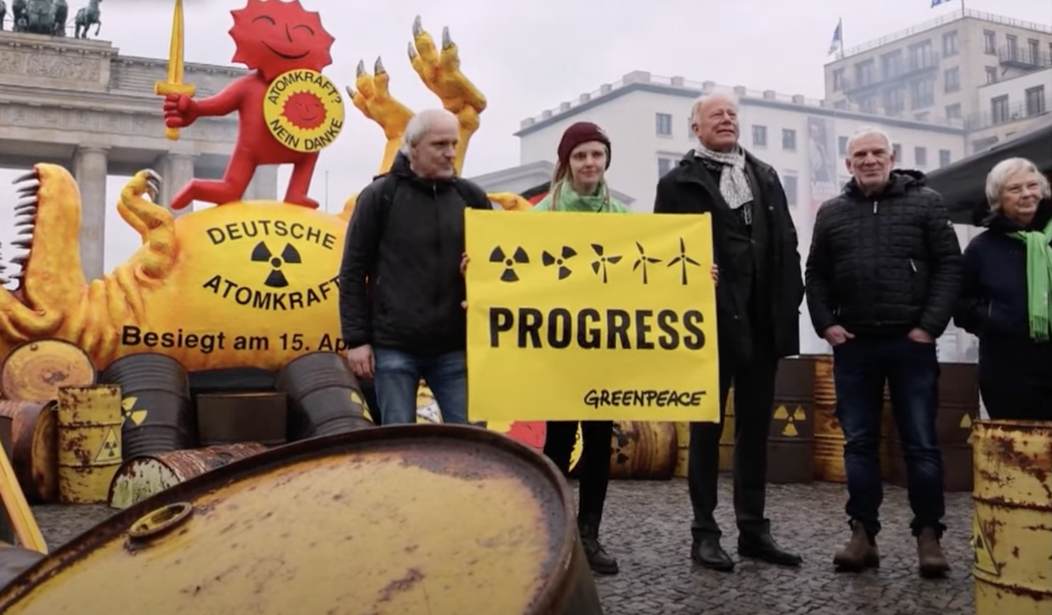Greens in Germany are celebrating the closure of the country’s last three operating nuclear power plants by holding a rally showing a figure representing solar power dancing on top of the dead body of a T-Rex.
It’s supposed to demonstrate the triumph of solar/renewable power generation over the dead biomass that turned into fossil fuels and powered human civilization for 150 years.
Ironically, the greens may have more in common with the dinosaurs than the sun. Germany, along with the rest of Western Europe, is in the grip of an energy crisis thanks to sanctions against Russian oil. And with pressure on Germany to achieve its emissions targets, reducing its use of fossil fuels will now be that much harder.
“The position of the German government is clear: nuclear power is not green. Nor is it sustainable,” Steffi Lemke, Germany’s Federal Minister for the Environment and Consumer Protection and a Green Party member told CNN.
“We are embarking on a new era of energy production,” she said.
Producing energy using what? Germany uses 46% renewable energy but is still short of its goals if it wants to hit its climate-mandated goal of using 80% renewables by 2030. And those goals would have been less arduous to reach without the 13.3% of nuclear energy the power plants supplied in 2021.
Even some greens think it’s madness to close perfectly good, low-carbon emitting plants at this time.
“We need to keep existing, safe nuclear reactors operating while simultaneously ramping up renewables as fast as possible,” Leah Stokes, a professor of climate and energy policy at the University of California, Santa Barbara, told CNN.
Even more problematic for German greens is the fact that the government has been forced to rely on more coal for power generation.
More than 30% of Germany’s energy comes from coal, the dirtiest of the fossil fuels – and the government has made controversial decisions to turn to coal to help with energy security.
In January, protestors including Greta Thunberg converged on the west German village of Lützerath in an unsuccessful attempt to stop it being demolished to mine the coal underneath it.
“Building new coal capacity is the opposite of what we need,” said Stokes. Fossil fuels are a climate problem, but they’re also a health risk, she pointed out. Air pollution from fossil fuels is responsible for 8.7 million deaths a year, according to a recent analysis.
How crazy is that? Not as crazy as 50,000 protesters forming a 27-mile human chain after the Fukushima disaster. That little stunt convinced Angela Merkel to give up on nuclear power entirely, promising to close the plants by 2022.
“Germany’s phase-out of nuclear power is a historic event and an overdue step in energy terms,” Simone Peter, president of the German Renewable Energy Federation (BEE), told CNN. “It is high time that we leave the nuclear age behind and consistently organize the renewable age.”
Perhaps it would be instructive to look at California’s efforts to rush a dependence on renewable energy. From September 2022 in the Washington Post:
As California suffered through an epic heat wave this month, state officials pleaded with residents to conserve electricity. Almost simultaneously, power grid operators were rejecting thousands of megawatts of solar and wind energy that could have provided a cushion to get through the crisis.
The explanation illustrates one of the paradoxes confronting California as it rushes to transition to a clean-energy economy: The state has built up so much renewable energy production in recent years that it can rarely use it all during peak production hours. But it also doesn’t have enough storage capacity to hang onto it for when it might be needed.
Germany and the rest of Western Europe were able to muddle through this rather mild winter, but what about next year? Are we all going to go back to being buddy-buddy with Putin and buying his oil as if nothing happened?
Next winter, we’ll see if the German people are celebrating their greenness so openly.










